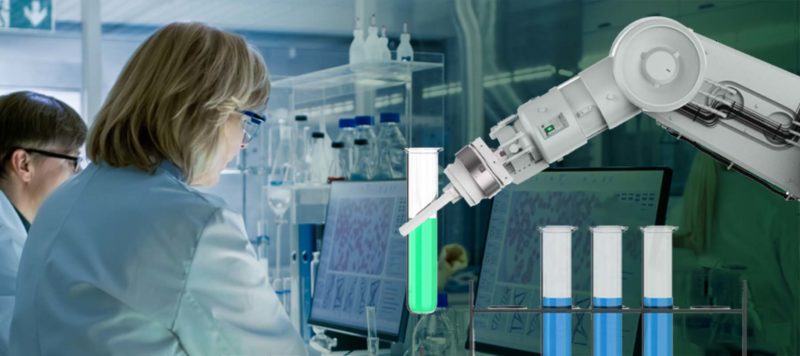No products in the basket.
PartnershipsProducts and SolutionsDevelopments in Laboratory Robotics and Automation
4 July 2022by verulam

Synthetic Biology Definition
As natural discoverers and problem-solvers, scientists habitually industrialize methods to investigate their queries and maximize lab productivity. This occurrence is especially noticeable by developing techniques and machinery that simplifies complicated and/or repetitive tasks. Technological advancements in laboratory robotics and automation over the last century have allowed scientists to mechanize many procedures, thereby allowing industrial, medical, and research labs to complete tasks that used to take months and years to a matter of days or even minutes.
Modern-day laboratory robotics and automation revolutionized in the 1950’s, with the first fully automated instrument- Auto Analyser SFA instrument was invented 1957 by Leonard Skeggs, PhD and commercialized by Jack Whitehead’s Technicon® Corporation. As more automated instruments evolved, automation management software was released in the 1970’s to form electronic logs and further improve lab efficiency. Today, a plethora of laboratory robotics and automation exists at the pre-analytical, analytical, and post-analytical stages across all scientific disciplines, with particular molecular, cellular, and microbiology evidence.
Read on to learn more about just a few applications in which laboratory robotics and automation could be applicable to your lab!
Laboratory Automation Systems: Microbiology
Given the ubiquity of microbes, many labs are dedicated to understanding their role in human, animal, and plant health and disease, symbiotic relationships, ecology, the environment, food safety, and so much more.
Furthermore, several molecular and cellular biology concepts were discovered by studying microbes, where microbial studies have formed the foundation for several pharmaceutical and gene editing inquiries. However, culturing microbes can become laboursome, where advancements in laboratory robotics and automation have aided microbiology research. Some of these advancements include:
- Media and reagent prep
- Microbe inoculation and streaking
- Incubation
- Analysis
- Identification
- Antibiotic testing
By using liquid handlers and reagent dispensers with proper digital pH meters, microbiologists can be assured media and reagents are properly prepared to their microbe’s needs. Additionally, innovations in colony picking technology allow for fast and accurate inoculation of specimens through a clean and efficient process. Images can be further collected as the automated picker selects colonies for ideal recordkeeping.
Finally, more automation in microbiology allows scientists to properly analyse their specimens by using plate readers to verify identification, test treatments, or monitor gene or protein expression changes.
Laboratory Automation Systems: Molecular and Cellular Biology
Many studies involving microbes, and countless other domains of life, include research centred on DNA and other concepts in molecular biology. Several of these processes have undergone advancements towards complete automation, including the polymerase chain reaction (PCR) process itself.
At first, a several hour process in which the scientist manually adds DNA polymerase after each cycle, PCRs today are now a largely hands-off task overseen by a thermocycler where the scientists mix their sample’s DNA and PCR reagents.
However, the PCR automation process was shown to be capable of further automation. By using automated liquid handlers and reagent dispensers, high throughput labs can have samples that are PCR-ready within moments.
This process can be solely completed in a microplate for labs growing their specimens, such as live bacterial and cell cultures. Cells can be grown, and then DNA extracted using a fully automated workstation, verified in a fluorescence microplate reader, amplified via PCR, and sequenced or otherwise analysed as needed. By completing all steps in a microplate, uniting laboratory robotics and automation products such as microplate stacking systems and microplate handlers, and coordinating the timing and sequence of steps using laboratory automation software, this entire process can be completely automated with minimal to no input from human technicians.
Similarly, thorough integration of several laboratory robotics and automation products can yield additional processes that can be completely automated in a cohesive robotics workstation. For example, RNA and proteins can also be extracted using the same DNA extraction workstation. RNA can be extracted, and reverse transcription reagents dispensed to run RT-PCRs, thus creating cDNA that is qPCR ready. Or, proteins can be purified and antibodies added for an automated ELISA workstation, using a fully automated microplate washer for repetitive washing steps.
Why Incorporate Laboratory Robotics and Automation in Your Lab?
By incorporating laboratory robotics and automation in industrial, medical, and research labs, scientists can increase accuracy, speed, safety, and overall work throughput. In particular, scientists can reduce time performing repetitive tasks, increase their time working on more demanding tasks, reduce human error, increase reproducibility, and collect data remotely.
Hudson Robotics has been the leader in laboratory automation for nearly 40 years. Speak to our UK distributor Verulam Scientific Ltd today to learn more about how your lab can benefit from laboratory robotics and automation!
Verulam Scientific Ltd [email protected] 01234 381000.
#VerulamScientific #Automation #Innovation #SamplePreparation #LiquidHandling #CustomisedSolutions #SyntheticBiology #HudsonRobotics #AutomatedLaboratoryEquipment #LifeScienceResearch #DrugDiscovery #ClinicalResearch #PharmaceuticalDevelopment #Screening #Proteomics #Genomics




